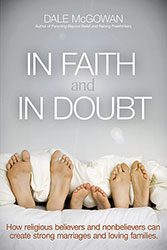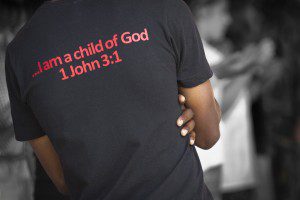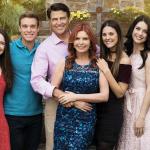 Across America, particularly among adults under age 33, secularism is on the rise. Nearly one third of Millennials, according to the Pew Research Center, don’t identify with a particular religion. And 20 percent of Americans overall describe themselves as nonreligous. So what happens when a nonbeliever falls in love with a believer?
Across America, particularly among adults under age 33, secularism is on the rise. Nearly one third of Millennials, according to the Pew Research Center, don’t identify with a particular religion. And 20 percent of Americans overall describe themselves as nonreligous. So what happens when a nonbeliever falls in love with a believer?
Popular author and secular humanist Dale McGowan has some answers. McGowan, a self-professed atheist from age 13, married a believing Baptist at age 28. His personal experience, as well as his professional experience as a parenting coach with mixed-belief couples, led him to write his latest book addressing the issue: In Faith and In Doubt: How Religious Believers and Nonbelievers Can Create Strong Marriages and Loving Families.
McGowan — who this month also took the reigns as the Managing Editor for the Patheos’ popular Atheist Channel — answered a few questions about his new book for our Book Club here. (You can also watch our video interview with him below.)
Q. Twenty-three years ago you were already an atheist, and you married a believing Southern Baptist. Why did it take you so long to recognize the need for a book devoted to the challenges of a secular/religious mixed marriage?
A. Partly because our marriage had so little conflict or tension around the difference. It didn’t occur to me at first that it was an issue. But when I began connecting with other couples in the same mix—some with serious tension and conflict—I wondered what accounted for the difference in their experience and mine.
 In your book, IN FAITH AND IN DOUBT, you start with the big picture on believers, nonbelievers, and the changing state of marriage in America. Would you share a few facts that defy conventional assumptions and pervasive stereotypes?
In your book, IN FAITH AND IN DOUBT, you start with the big picture on believers, nonbelievers, and the changing state of marriage in America. Would you share a few facts that defy conventional assumptions and pervasive stereotypes?
Most people assume that the beliefs of a given person match the doctrines of that person’s denomination. But there’s often a huge difference. The Catholic Catechism, for example, calls birth control “intrinsically evil,” yet 82% of US Catholics consider it morally acceptable. More than half of religious Americans (56%) believe atheists can go to heaven—not to mention 100% of current popes! On the other side, atheists are often assumed to be uniformly hostile to all religion—in other words, to be “anti-theists.” But a recent University of Tennessee study determined that just 14.8% of atheists are actually antitheists. The rest—more than 85 percent of atheists—fall along a spectrum from selective rejection of religious ideas and practices to the heartfelt embrace of religious ritual and actively seeking coexistence.
What are some red flags that a mixed-belief marriage will be a difficult one?
One of the biggest red flags is a strong desire to convert (or deconvert) one’s partner. A survey I conducted of nearly 1000 people in secular/religious marriages found a strong correlation between the desire to convert and tension and conflict in the marriage. Another is a midstream change by one partner. If both were religious at the wedding, for example, and one later becomes nonreligious, there is often a feeling of betrayal and disorientation for the other partner—a sense that the agreed-upon foundation of the marriage no longer exists. Hostility or a lack of support from extended family is another serious stressor, one that a recent Harvard study showed is often bad not only for the relationship but for the physical health of the individuals in it.
What practices can help mixed-belief couples identify and deal with potential conflict before they escalate into ongoing sources of tension and pain?
Communication, especially early on, is number one. When couples talk about their values (what is good), they usually discover that these are closely aligned even if they differ on beliefs (what is true). And values have a greater impact on day-to-day life. Fortunately when it comes to communication, mixed-belief couples often have superpowers. Marriage researchers call it “dyadic consensus”—the ability to communicate effectively and come to agreement about important issues—and several studies indicate that mixed-belief couples often show much greater strength in that area than couples who share the same beliefs. Why? Because they have to. Couples in same-faith relationships can take a lot for granted. But a religious difference requires couples to confront issues that call for effective communication right out of the gate, and those skills carry over into other aspects of the relationship.
You encourage secular/religious partners to find common ground. In what areas, specifically? How can common ground include religious practices like churchgoing and prayer?
The common ground refers mostly to values, the things they consider important and good. It can also extend to practices like parenting, where the nonreligious and progressive religious can often find plenty of agreement, from discipline to granting kids the autonomy to find their own way in religious questions. But even practices like churchgoing can be a source of common ground. I attended church with my wife for ten years and often found it interesting, peaceful, and sometimes even inspiring. Not always, but sometimes! We were experiencing it in different ways, but the common ground was the shared act of being together in that space once a week. As for prayer, one of the couples featured in the book described their own process for deciding what to do about grace before a meal when David deconverted. He knew it was important to Hope, his wife, so he didn’t want to discard the practice entirely. He just wanted to preserve it in a way that wouldn’t exclude or marginalize him. It was difficult for her to consider at first, but she described his approach to the topic as “wonderful and gentle.” They eventually settled on a compromise—a lovely, simple grace that expresses their gratitude for the meal and for each other without specifically invoking or excluding God. They found the common ground.
For many couples, differences in belief aren’t a major issue—until they have kids. What are some successful approaches to raising children with an understanding of religion and autonomy to make their own belief choices?
Kids have the best chance of finding their own way if they aren’t labeled with any worldview, atheist or religious, until they are old enough to choose it themselves. This strikes some people as unthinkable, but it shouldn’t. We wouldn’t refer to a child as a Republican child or a Marxist child. Those represent complex perspectives that are much more likely to reflect a parent’s decisions than their own. Fortunately many religious and nonreligious parents alike are serious about letting their kids have that gift of real freedom of thought and belief. That doesn’t mean kids shouldn’t engage in religious and irreligious pursuits. A child can go to church or Sunday school, read the Bible, and pray without being called a Christian, Muslim, or Jew, just as she can challenge religious ideas, debate religious friends, and read The God Delusion without being an atheist. A child with one religious and one nonreligious parent is in a uniquely lucky position to do all of these things—learn religious concepts and challenge them, engage in religious practice and wonder if they are meaningful, pray and question whether her prayers are heard.
Throughout IN FAITH AND IN DOUBT, you share the stories of eight actual secular/religious couples. How are their experiences both representative and unique?
I made an effort to get a wide range of situations. There’s a Baptist and an atheist who were already different at their wedding, and another Baptist whose Baptist husband became a nonbeliever after several years of marriage. There’s a Hindu woman with a nonreligious husband, a Catholic and an atheist who meet in Unitarianism, a couple who just wed after their state legalized gay marriage, a believer and nonbeliever who actually switched beliefs, and so on. Every couple was unique in their story and the way the elements have played out, but they also displayed patterns that connect them to every other couple in this mix. Four of the eight have remained together, and four have not. Figuring out what accounts for the difference is the central task of the book.
You write about wonderful benefits experienced by couples in a mixed-belief marriage. What are some of those benefits?
I asked that same question in my secular/religious marriage survey, and their wonderful answers make up the last chapter. They said they find themselves more tolerant and relaxed toward people of other worldviews, more accepting of difference generally, and less extreme in their own views. They describe those communication “superpowers” they’ve developed. They say they’ve learned more about their partner and have deeper, more interesting conversations than they might if they shared the same assumptions. They’ve learned to think more carefully before they speak, and it’s made them better thinkers and speakers. Many describe a new dimension to their relationship after a partner stands up for their rights against hostility from family members. And many credit their partner with helping them see a larger world outside of the “bubble” of their belief system. And they talk about the joy of passing this tolerance, depth, thoughtfulness, and openness to their kids. All of these things are possible in same-belief couples as well, of course. But the secular/religious relationship seems to offer a special opportunity to really make these benefits shine.












